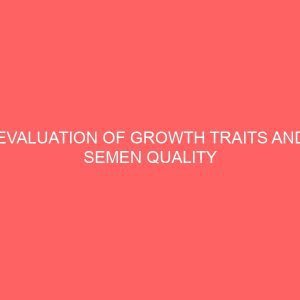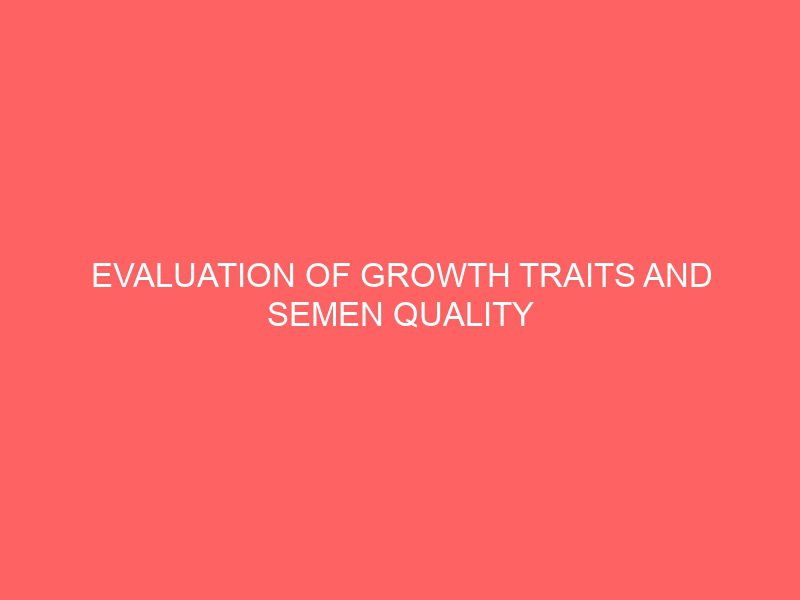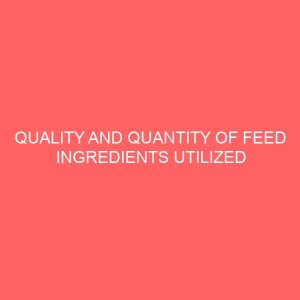Description
ABSTRACT
A study was conducted using 231 chicks (101 Normal feather, 56 frizzle and 74 Naked neck) to evaluate growth traits and semen quality characteristics using biochemical and IGF-1 as molecular marker on three genotypes (normal, frizzle and naked neck) of Nigeria indigenous chickens. Each of the genotypes comprised of twenty five hens and five roosters mated in the ratio of 1 rooster: 5 hens (1:5). Body weight (BW) and measurements of breast girth (BG), shank length (SL), body length (BL), wattle length (WL), wattle width (WW), comb length (CL), comb height (CH), wing span (WS) and shank diameter (SD) were taken at an interval of 4 weeks starting from 8 weeks of age. Semen quality characteristics (volume, colour, pH, concentration and live and dead ratio) and morphological defects (acrosoma swelling, detached head, mid piece drop, bent tail, curled tail and full tail) were evaluated thrice at 24, 28 and 32 weeks of age, respectively. Blood samples for the haematological, biochemical and molecular studies (IGF-1) were collected at 20 weeks of age. The data collected were subjected to General Linear Model procedure of SAS. The result showed that mean BW between 8 and 20 weeks ranged from 310.46g to 1117.80g and between 1096.80g and 1285.80g from 24 to 32 weeks with significant (P<0 .05="" 20="" 32="" age.="" ages="" all="" and="" apart="" at="" between="" birds="" bl="" body="" bw="" differences="" feathered="" from="" having="" however="" linear="" measurements="" normal="" not="" of="" other="" significant="" significantly="" superior="" the="" to="" weeks="" were="" which="" with="">0.05) different at all the ages (8 to 32 weeks). The semen quality characteristics for the parameters were significantly (P<0 .05="" and="" colour="" different="" except="" for="" not="" ph="" semen="" significant="" were="" which="">0.05) affected by the age of the birds. The morphological defects showed that most of them were significantly (P<0 .05="" all="" but="" different="" for="" genotypes="" mid="" not="" piece="" significantly="" the="" was="">0.05) different at 32 weeks. The results of the haematological and biochemical profile show that only Chloride in the biochemical parameter was significantly (P<0 .05="" between="" but="" coefficients="" correlation="" different.="" had="" not="" phenotypic="" positive="" show="" significant="" some="" statistically="" that="" the="" traits="">0.05) while others traits showed between moderate and high correlations amongst themselves. Two alleles; A and B and three genotypes: AA, AB and BB were observed with the A allele (0.72) being predominant and conforms to Hardy-Weinberg equilibrium. The relationship among IGF-1 marker, BW and semen quality was significant (P<0 .05="" 28="" 32="" a="" aa="" ab="" age="" and="" as="" at="" bb="" better="" body="" bw="" characteristics="" chickens.="" concluded="" did="" feather="" for="" gene="" genetic="" genotype="" genotypes="" good="" growth="" had="" igf-1="" improved="" in="" increased="" indigenous="" is="" it="" linear="" making="" marker="" measurements="" nigerian="" normal="" of="" over="" positive="" quality="" relationship="" revealed="" selection="" semen="" span="" superior="" terms="" that="" the="" therefore="" to="" traits="" up="" was="" weeks.="" weeks="" weight="" while="" with="">
CHAPTER ONE
1.0 INTRODUCTION
The poultry industry is a versatile business in Nigeria but the development has been to the detriment of the indigenous birds which have been neglected and not properly managed (Adebambo et al., 1999). The indigenous chickens (Gallus domesticus) have been kept in Africa for many generations in subsistence systems.
The Nigerian indigenous chicken constitutes between 80 and 90 percent of the local population of chickens in Nigeria. Three other major genes have been identified in these local chickens apart from the normal feathered type. These are: Frizzle, naked neck and sex-linked dwarfism. Each of these genes plays a significant role in the productive adaptability of the Nigerian local chicken (Ozoje and Ikeobi, 1995). Despite being in Nigeria for long, the indigenous chickens consist of various unimproved sub-populations of heterogeneous characteristics, not yet classified into breeds and varieties since they do not breed true to type and have no clear plumage colours (Obioha, 1992; Ibe, 2001).
The indigenous chicken, also known as the local chicken is the general term given to those chickens kept on an extensive system, scavenging free-range, having no identified description, and being dual-purpose and unimproved (Horst,1989; Pedersen, 2002). They appear to be the cheapest and sustainable means of producing high quality animal protein for the expanding populations of developing countries like Nigeria. They are self reliant and hardy birds with the capacity to withstand harsh weather conditions and adaptation to adverse environments.







